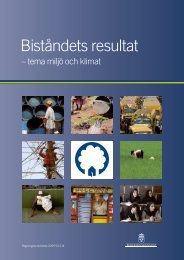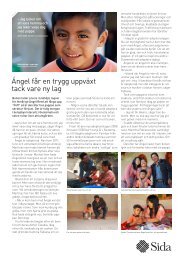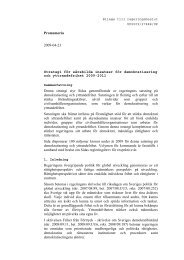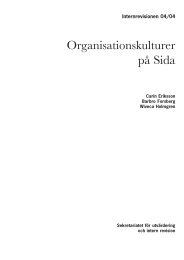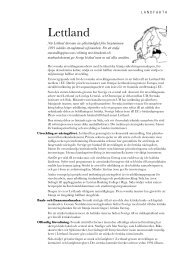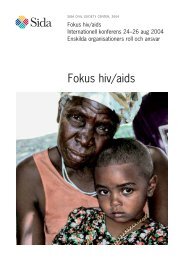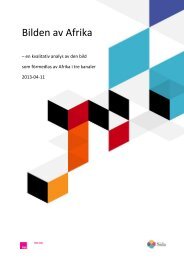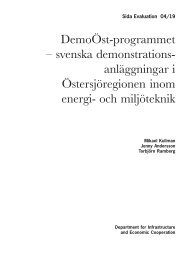Mid-Term Review of the AGIR Programme - Sida
Mid-Term Review of the AGIR Programme - Sida
Mid-Term Review of the AGIR Programme - Sida
Create successful ePaper yourself
Turn your PDF publications into a flip-book with our unique Google optimized e-Paper software.
2 F I N D I N G S<br />
tive <strong>of</strong> Rede da Criança, with experience in receiving and managing funds, was still<br />
noting <strong>the</strong> very low amount <strong>of</strong> funding received from headquarters. This has, on one<br />
occasion, forced it to fund an activity <strong>of</strong> <strong>the</strong> network in Nampula related to <strong>AGIR</strong><br />
with its own resources. The Juvenile Parliament also expressed its concerns about a<br />
lack <strong>of</strong> funding to local level activities. These are some examples showing that <strong>the</strong><br />
implementation <strong>of</strong> <strong>the</strong> partners’ activities at <strong>the</strong> local level is still a critical point, despite<br />
attempts to solve this problem.<br />
The problem <strong>of</strong> funds reaching <strong>the</strong> local level is being addressed with more consistency<br />
this year in <strong>the</strong> sub-programme managed by Diakonia as a result <strong>of</strong> its monitoring<br />
field missions. The evaluation team had access to 8 out <strong>of</strong> 9 partners’ action<br />
plans, dated September 2012 (CEDE (Centre for Studies on Democracy and Development),<br />
Electoral Observatory, LDH, AMMCJ (Association <strong>of</strong> Mozambican Women<br />
in Legal Career), Rede CAME, Juvenile Parliament, MULEIDE (Association for<br />
Women, Law and Development). These plans include <strong>the</strong> decentralisation <strong>of</strong> funds,<br />
involvement <strong>of</strong> local level partner organisations’ branches or network members in <strong>the</strong><br />
planning process for 2013, and a mobilisation <strong>of</strong> funds by <strong>the</strong> latter to be more autonomous<br />
from <strong>the</strong> central level. This is a signal that <strong>the</strong> programme is well-aware <strong>of</strong> this<br />
gap, but with only two years remaining until <strong>the</strong> end <strong>of</strong> <strong>the</strong> programme, local-level<br />
CSOs will need extra effort to yield results attributable to <strong>the</strong> implementation <strong>of</strong><br />
<strong>AGIR</strong>. If <strong>the</strong> experience with <strong>the</strong> central level has shown that it took almost two years<br />
for most <strong>of</strong> <strong>the</strong> organisations to be acquainted with good governance and management<br />
practices, and this was learned and improved by doing, it would be expected that <strong>the</strong><br />
implementation <strong>of</strong> <strong>the</strong> programme at <strong>the</strong> local level will face similar problems – an<br />
even more challenging process taking into account <strong>the</strong> capacity constraints that exist<br />
at this level.<br />
Implementation <strong>of</strong> CSO workplans<br />
The implementation <strong>of</strong> <strong>the</strong> work plans has evolved. At <strong>the</strong> beginning <strong>of</strong> 2010, <strong>the</strong><br />
workplan was only partially implemented. In <strong>the</strong> subsequent years, <strong>the</strong> level <strong>of</strong> implementation<br />
increased, although planned activities were not always implemented.<br />
Reporting on <strong>the</strong> work plans tends to analyse challenges and constraints and less <strong>the</strong><br />
level <strong>of</strong> implementation. There were also cases <strong>of</strong> mismanagement that resulted in <strong>the</strong><br />
suspension <strong>of</strong> <strong>the</strong> partners (MISA, MONASO MEPT) and a reduced pace <strong>of</strong> implementation.<br />
CSO Partner Activities<br />
When it comes to partners, <strong>the</strong> consistency <strong>of</strong> activities regarding <strong>the</strong>ir contribution to<br />
<strong>the</strong> programme’s outcomes is sometimes not clear. <strong>AGIR</strong> agrees with partner organisations<br />
on a set <strong>of</strong> activities aligned to <strong>the</strong> objectives <strong>of</strong> <strong>the</strong> programme, or <strong>of</strong> <strong>the</strong> subprogrammes.<br />
Initially, <strong>the</strong> selection <strong>of</strong> <strong>the</strong>se partners was made based on <strong>the</strong> fact that<br />
<strong>the</strong> partners had a strategic plan that overlaps with <strong>AGIR</strong> objectives or a history <strong>of</strong><br />
intervention in <strong>the</strong> relevant areas. Therefore, <strong>the</strong> activities <strong>of</strong> <strong>the</strong>se CSOs <strong>the</strong>oretically<br />
cannot fall outside <strong>the</strong> scope <strong>of</strong> <strong>AGIR</strong>. But since <strong>AGIR</strong> funds <strong>the</strong> CSO’s strategic<br />
plan through a process <strong>of</strong> good donorship, <strong>the</strong>re can be cases where activities might<br />
46




